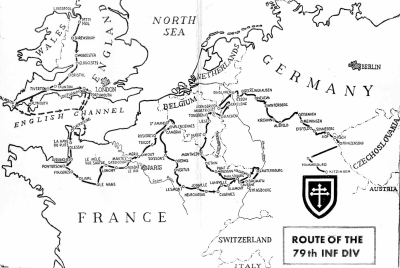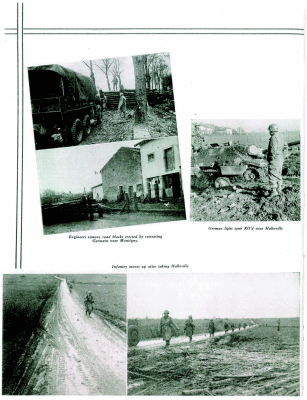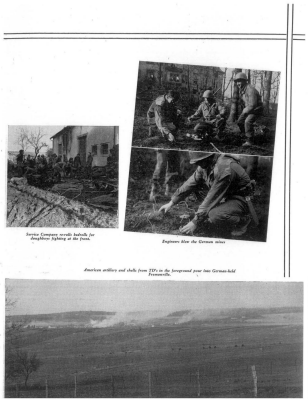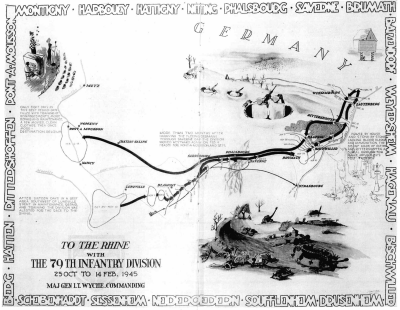|

79ème Division
d'infanterie américaine - 1944

The Cross of
Lorraine; a combat history of the 79th Infantry Division
June 1942-December 1945
Ed. United States. - 1946

[Novembre 1944]
After 16 days in rest areas around the city of Luneville,
France, the 79th Infantry Division was assigned the task
of forcing a passage through the Vosges Mountains and
driving the enemy out of Alsace.
The Germans were established along the eastern foothills
of the Vosges where they had constructed an elaborate
defensive line, which in the XV Corps sector, ranged
from Rechicourt le Chateau south to Blamont, then along
a ridge to Harbouey and on to the vicinity of Baccarat.
This line, which at times utilized World War I
fortifications, consisted of anti-tank obstacles,
pillboxes, fortified gun emplacements, weapons pits and
strongpoints. A re-arranging of Army boundaries put this
sector under Seventh Army control.
The Germans hoped to be able to hold along this line
through the bitter Alsatian winter or, at least, along
the Vosges Mountains themselves. Historically and
militarily the Vosges Mountains had proved the efficacy
of that favorite German adjective: "Impregnable."
The Seventh United States Army planned to attack and
break through this line and the mountains and seize the
key city of Strasbourg. XV Corps was assigned the twin
tasks of capturing Sarrebourg and forcing the Saverne
Gap, and was to be ready to exploit gains east of the
mountains. Corps earmarked the 79th Division for a
spearhead attack along the Ancerville-Nitting line. Its
orders called for the capture of Sarrebourg with
assistance of the 44th Infantry Division and it was to
be instantly ready to continue the attack to the
northeast.
On November 9th, plans for the attack, which were for
0700, November 13th, were made. It was decided that the
314th and 315th Infantry Regiments would seize the
initial objective, the ridge just north of Harbouey. At
the same time the Second French Armored Division was
assigned the mission of exploiting the 79th Division's
gains after the breakthrough.
In preparation for the attack, the Division moved to new
assembly areas in the vicinity of Montigny, with the
313th Regiment placed in Division reserve in Brouville,
and, by the early morning of the 13th, all was in
readiness for the attack.
When all combat teams jumped off for the attack there
was very little resistance, but, as the advance
continued, the 314th Regiment's attack met stiff
resistance with artillery fire holding them down in
place. By darkness of the initial day of the attack, the
regiment had occupied advanced positions and
consolidated its rear for the night. On November 14th
the Second Battalion moved near Migneville and, despite
several hours of heavy small arms and artillery fire,
the town was cleared.
The next day's plans called for the 315th Regiment to
push on and occupy Halloville, after which a
reconnaissance force of the Second French Armored
Division was slated to move through towards Nonhigny and
Paru. The 314th Regiment was to stand fast, limiting its
activity to patrols, while the Third Battalion of the
313th Regiment would relieve the Third Battalion of the
315th Regiment. After Halloville had been taken, both
the 314th and 315th Regiments were to be ready to move
on an hour's notice up to the Division's objective, the
ground north and southeast of Harbouey, respectively.
On the morning of the 15th, the First Battalion of the
315th Regiment attacked to clear the enemy from
Halloville. The Battalion met heavy resistance, but,
with excellent assistance from tanks and TD's, it soon
had driven the enemy from the village. Five enemy tanks
and several other vehicles were destroyed and 91
prisoners captured in this operation.
The enemy did not elect to make a stand in Harbouey but
threw in heavy small arms fire as they retreated to
prepared positions. Gradually the 79th Division was
encircling Blamont, one of their main objectives. The
town of Barbas, south of Blamont, was the next to fall
to the rapid advance of the Cross of Lorrainers. The
Third Battalion of the 315th Regiment had cut off all
roads leading into the town with 79th Division men
entering the sector two hours later. It was estimated
that 300 enemy infantry and four tanks fled the town
toward Blamont as the Division approached. Following the
capture of Barbas, patrols probed towards Blamont while
the Third Battalion of the 314th Regiment secured a
crossing over the Vezouse River near Fremonville.
In the 314th Regiment's sector considerable difficulty
was encountered because the bridge northeast of Barbas
had been blown by the retreating Germans. To Company A
of the 304th Engineer Battalion went the task of putting
up a treadway bridge. The Engineers had to cease work
several times when enemy artillery fire came too close
for comfort, but on the next day, November 17th,
friendly artillery laid down a protective barrage and
the engineers completed the bridge.
At this point in the campaign, a task force of the
French began operating in the Division's sector and
captured Nonhigny, Montreux, Badonviller and Bremenil.
Enemy resistance collapsed in Blamont, and the city was
mopped up by the 315th Regiment on November 19th.
During this phase of the operation the Division again
fought the German's 708th Infantry Division, which it
had previously contacted near Le Mans. The week's heavy
fighting had resulted in the Division driving into the
enemy's lines a deep wedge which practically cut off the
728th Infantry Regiment from the rest of the 708th
Infantry Division. This action cost the enemy heavy
casualties, and 637 prisoners were taken. The past
week's action was considered by high military leaders as
most important for it caused the enemy to fall back each
night in front of the 44th Infantry Division on the left,
giving up easily defendable terrain. On the Division's
right flank there was no adjacent unit, and after
forcing of the Vezouse River, the enemy's withdrawal
became a rout and the French were enabled to make their
brilliant advance through the Vosges Mountains to
Strasbourg.


 |













